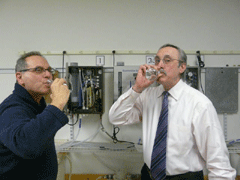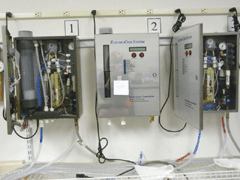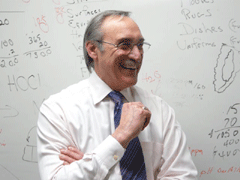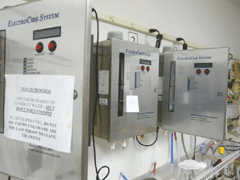Magic Water
Air Date: Week of February 27, 2009

Bruce Gellerman (left) and Patrick Lucci toast to electrolyzed water. (Photo: Liz Gross)
Electrolyzed water - salt water that has been zapped with electricity - can be used as a detergent and a disinfectant. Host Bruce Gellerman visits with Patrick Lucci, vice president of marketing for the Electrolyzer Corporation in Massachusetts, and learns more about a simple process that could make big bucks.
Transcript
GELLERMAN: In Russia they pour it down oil wells to kill trouble-making microbes.
In New Mexico it’s used to neutralize germs in the guts of cows - and in Japan, it disinfects taxicabs.
IT is electrolyzed water - salt water that’s been zapped with electricity and turned into powerful - but safe - detergent and disinfectant.
The Electrolyzer Corporation of Woburn Massachusetts makes the machines that make the water. Patrick Lucci is Vice President of Marketing.
LUCCI: An electrolyzer is a device that basically makes two solutions out of salt water and electricity. One solution is a sanitizer that at 50 parts per million is more effective than chlorine bleach at 200 parts per million, yet it’s so non-toxic you can drink it. The other is a form of sodium hydroxide that’s used as a detergent for floors, carpets or anything else you would wash.
GELLERMAN: Magic water.
LUCCI: I don’t like to call it magic water, but a lot of people do.

The electrolyzer. (Photo: Liz Gross)
GELLERMAN: So take me through the process. How do you create something out of water that has such powerful properties that it can be both a disinfectant and a cleaner?
LUCCI: Let me take you in the lab, and I’ll show you.
GELLERMAN: Okay.
[FOOT STEPS]
LUCCI: It’s a fairly simple process. It’s something that you probably learned in your high school chemistry class, but forgot. So here is an electrolyzer.
[MACHINE SOUNDS]
LUCCI: There is a positive electrical charge in this left chamber, a negative electrical charge in the right chamber. Now these two chambers are lined with ion permeable membranes, and they’re smart membranes. The ones that line this left-hand chamber only allows the migration of chloride ions into the chamber. The chloride ion is negatively charged in nature. When it hits the positive electrical charge here, it’s electrochemically converted from Cl to HOCl, which is hypochlorous acid.
GELLERMAN: Cl is …?
LUCCI: Chloride.
GELLERMAN: And hypochloric acid?
LUCCI: Hypochlorous acid, HOCl.
GELLERMAN: And what is hypochlorous acid?

Patrick Lucci. (Photo: Liz Gross)
LUCCI: Hypochlorous acid is an antibacterial solution. It’s extraordinarily efficient, extraordinarily powerful. Now in the right chamber there is a negative electrical charge. The sodium ion is the only ion allowed in there by the ion permeable membrane. The negative electrical charge attracts the positively charged …
GELLERMAN: It’s been a while since high school, and Pat Lucci’s right, I did forget my basic chemistry. He gave me a remedial lesson on a white board.
LUCCI: So basically what we have is we have two chambers …
[SCREECHING OF MARKERS ON A WHITE BOARD]
LUCCI: … and we’ve got salt water.
[SCREECHING OF MARKERS ON A WHITE BOARD AND THE SOUND OF RUNNING WATER]
LUCCI: And we’re taking the salt water, and we got a positive charge here, negative charge here. We’re putting tap water into the chambers. As we’re pumping the salt water through in between these chambers, the chloride ions migrating into here and the sodium ions are migrating here. When the chloride ion hits the positive electrical charge, it’s electrochemically converted to HOCl, and it exits the chamber into a storage tank. The sodium is zapped with a negative electrical charge, because it’s positive, and it exits as sodium hydroxide, NaOH. Simple as that.
GELLERMAN: So basically what you’re doing is you’re taking a salt water and splitting it.
LUCCI: We’re splitting the salt. The hypochlorous acid is a sanitizer; the sodium hydroxide is a cleaner. Sodium hydroxide is a basic element in just about every soap and detergent out in the market. It’s a grease cutter.
GELLERMAN: How good a grease cutter?
LUCCI: Depends on the concentration. In the concentrations that we make which are about 166 parts per million, it’s good enough to clean a floor – if you heat it – it’s good enough to clean a floor without soap and it’s good enough to clean a rug without soap. It’s also good enough to clean dishes without soap. And we’ve proven that in every hotel that we’ve install units in.

The electrolyzer. (Photo: Liz Gross)
GELLERMAN: So what you sell is these units, these boxes.
LUCCI: Yeah. We sell the box.
GELLERMAN: Well what are the benefits of this stuff as compare to the, you know, Mr. Clean?
LUCCI: A lot. First of all, according to the Environmental Protection Agency 27,000 hotel workers every year are harmed by harmful chemicals. We make that go away. We take away all of the bleach, all the quaternary ammonia, all the detergents. Hotel workers have less sick time, fewer injuries because of chemicals and the hotel management saves on all of those workers compensation cases. Those are the primary benefits. The other benefits are cost. We make these two solutions at the cost of roughly a penny a gallon, which is significantly less than the cost of the chemicals they use. So an operation like for example the Royal Sonesta in Cambridge Massachusetts, they’re saving $500 a month just in housekeeping. And the machine pays for itself in actually under a year. When we bring the dishwashing application online they will save an additional $10,000 a year on dishwashing detergent.
GELLERMAN: Now the disinfectant, that’s called …?
LUCCI: Hypochlorous acid.
GELLERMAN: And how does that work? Why is it so powerful?
LUCCI: Hypochlorous acid is a form of chlorine that exhibits zero cytotoxicity. That means that it is harmless to human and animal cells. However, it is highly reactive with proteinaceous material.
GELLERMAN: So if you had a virus from influenza, it would kill it?
LUCCI: Yes. It does kill the influenza virus very effectively.
GELLERMAN: Anthrax bacilli?

Bruce Gellerman (left) and Patrick Lucci toast to electrolyzed water. (Photo: Liz Gross)
LUCCI: Anthrax is a bacteria, but it kills it, yes. It also kills HIV.
GELLERMAN: Now, and it’s harmless to me. Can I take a swig?
LUCCI: Yep.
GELLERMAN: Really?
LUCCI: Yeah.
GELLERMAN: Could you take a swig?
LUCCI: Watch me. I’ve done it. I’ve done it many times.
[SOUNDS OF LAB GLASSWARE]
LUCCI: Alright, the first thing I’m going to do is I’m gonna prove to you - by emptying some of this solution into a cup – I’m going to prove to you that there’s chlorine in there. These test strips measure free chlorine.
[SLOSHING SOUNDS]
LUCCI: So I’m going to take a test strip out of the bottle. I’m gonna wave it around in this little cup full of water.
GELLERMAN: And – voila – it turns blue.
LUCCI: And as you can see we are looking at somewhere around 50 parts per million in free chlorine.
GELLERMAN: Does it smell?
LUCCI: Sure does.
GELLERMAN: Oh yeah, it’s got that kind of swimming pool smell.
LUCCI: Yeah.
[SOUNDS OF DRINKING: “AHHH”]
LUCCI: Betcha wouldn’t do that with bleach.
GELLERMAN: You’re not gonna keel over later.
LUCCI: Not any time soon. The biggest down side to drinking this is that if you do it regularly or in large volumes you’ll create an imbalance between the good bacteria and bad bacteria in your body and get some sort of an infection.
GELLERMAN: But what happens if you had like food poisoning? Could you take this? Would it kill the food poisoning?
LUCCI: No, by the time you have food poisoning it’s too late. But treating your food products with the water helps to avoid food poisoning.
GELLERMAN: So you could spray this on….
LUCCI: Spray it on – oh absolutely. As a matter of fact, one of the biggest applications in Japan is spraying this on sushi. But it’s very – it’s a great hand sanitizer. If you put some on your hands and rub it around on your hands and let it dry, right now, you’ll have a fine hint of chlorine.
GELLERMAN: Uh huh.
LUCCI: As soon as that dries, you won’t smell the chlorine any more and the reason is hypochlorous acid wants to be a gas. So as the water evaporates, the hypochlorous acid goes off into the air, so there’s no residue. So you put this on fruits and vegetables, you’ll a) make them safer to eat, and b) you’ll extend their shelf life because you’ll kill all the bacteria.
GELLERMAN: So what am I missing about this process?
LUCCI: I don’t think you’re missing anything. I think you’re getting it.
GELLERMAN: Well, Mr. Lucci, thank you very much.
LUCCI: Well, thank you very much. It was great for you to come over and I’m glad we gave you a little science lesson.
GELLERMAN: Pat Lucci, Vice President of Marketing at Electrolyzer Corporation in Woburn, Massachusetts, hopes to clean up with their machines, which make electrolyzed water. There are drawbacks right now, the machines are too pricey for the average home and the stuff loses its potency fairly quickly, so it can’t be stored for long.
Living on Earth wants to hear from you!
Living on Earth
62 Calef Highway, Suite 212
Lee, NH 03861
Telephone: 617-287-4121
E-mail: comments@loe.org
Newsletter [Click here]
Donate to Living on Earth!
Living on Earth is an independent media program and relies entirely on contributions from listeners and institutions supporting public service. Please donate now to preserve an independent environmental voice.
NewsletterLiving on Earth offers a weekly delivery of the show's rundown to your mailbox. Sign up for our newsletter today!
 Sailors For The Sea: Be the change you want to sea.
Sailors For The Sea: Be the change you want to sea.
 The Grantham Foundation for the Protection of the Environment: Committed to protecting and improving the health of the global environment.
The Grantham Foundation for the Protection of the Environment: Committed to protecting and improving the health of the global environment.
 Contribute to Living on Earth and receive, as our gift to you, an archival print of one of Mark Seth Lender's extraordinary wildlife photographs. Follow the link to see Mark's current collection of photographs.
Contribute to Living on Earth and receive, as our gift to you, an archival print of one of Mark Seth Lender's extraordinary wildlife photographs. Follow the link to see Mark's current collection of photographs.
 Buy a signed copy of Mark Seth Lender's book Smeagull the Seagull & support Living on Earth
Buy a signed copy of Mark Seth Lender's book Smeagull the Seagull & support Living on Earth

